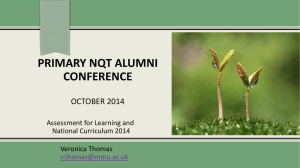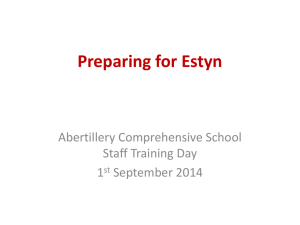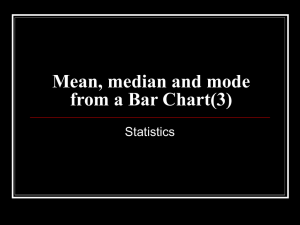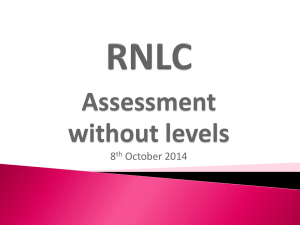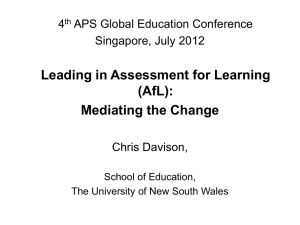Assessment. - Shepway Teaching Schools
advertisement
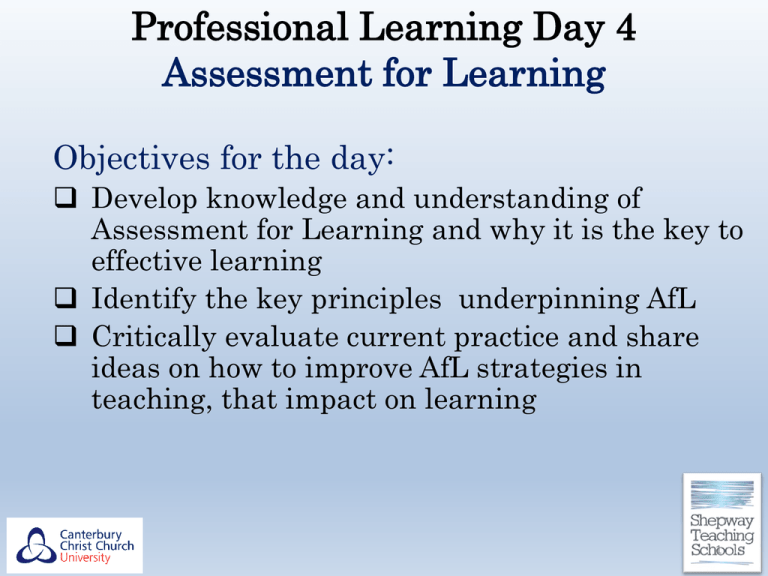
Professional Learning Day 4 Assessment for Learning Objectives for the day: Develop knowledge and understanding of Assessment for Learning and why it is the key to effective learning Identify the key principles underpinning AfL Critically evaluate current practice and share ideas on how to improve AfL strategies in teaching, that impact on learning 1 What is the purpose of assessment? Discuss 2 Formative Assessment… Some definitions “… undertaken by teachers and their students, which provides information to be used as feedback to modify the teaching and learning activities in which they are engaged…the evidence is actually used to adapt the teaching work to meet the needs.” Black and Wiliam, (1998) “… provides feedback which leads to students recognising the (learning) gap and closing it … it is forward looking …” Harlen, (1998) 3 Summative Assessment… Some definitions “… assessment (that) has increasingly been used to sum up learning” Black and Wiliam, (1998) “… is carried out at intervals when achievement has to be summarised and reported.” Harlen, (1998) 4 formative assessment Provides information which can aid further progress, diagnose reasons for both good and poor performance, and target particular learning needs summative assessment Measures and reports on pupils’ progress, as a ‘verdict’ on what has been achieved; it summarises achievement and occurs near the end of a piece of work 5 Formative Assessment Summative Assessment 6 1) What key principles of AfL have I ignored? 2) Discuss your feelings with those on your table 3) What impact does the score have on your learning? 7 There are 10 key elements of AfL What is AFL? Sort the cards & discuss implications for classroom practice: Categorise them into which are important for the teacher Which important for the learner Rank 8 Does this surprise you? Research presented by Dylan Wiliam – SSAT Academies Conference (2009) 9 The history and theory behind AfL: The research Inside the Black Box 1998 research paper “Raising standards Through classroom assessment” Black & Wiliam “formative assessment raises standards of achievement and equips children for lifelong learning” 10 Research informed Practice The research indicates that improving learning through assessment depends on five key factors o The provision of effective feedback to pupils o The active involvement of pupils in their own learning o Adjusting teaching to take account of the results of assessment o A recognition of the profound influence assessment has on the motivation and self esteem of pupils, both of which are crucial influences on learning o The need for pupils to be able to assess themselves and understand how to improve Black and Wiliam (1998: 5) What factors might inhibit this process? Discuss 11 Characteristics of assessment that promotes learning o Assessment is embedded in a view of teaching and learning, of which it is an essential part o It involves pupils sharing learning goals with pupils o It aims to help pupils to know and to recognise the standards they are aiming for o It involves pupils in self assessment o It provides feedback which leads to pupils recognising their next steps and how to undertake them o It is underpinned by the confidence that every pupil can improve o It involves both teacher and pupils reviewing and reflecting on assessment data Black and Wiliam (1998:7) 12 From research … 5 “key strategies” Feedback: Give feedback that moves learners forward Sharing learning Expectations: Clarifying and sharing learning goals. Engineering effective classroom discussions, Questioning: questions, tasks and activities that elicit evidence of learning Self Assessment: Activating students as owners of their own learning Peer Assessment: Activating students as learning resources for one another (Wiliam & Thompson, 2007) 13 Context within lesson Form / nature of the evidence Whole Class Intro e.g. Mental / Oral Starter in Maths Questioning, verbal discussion eliciting strategies children used to reach a solution. Whiteboard/show me visual tools. Talk partners Practical activity Observations of play Observations and discussions with children (particularly where children are using practical equipment) Written outcomes Exercise books, test scripts. Group work (similar to practical activity but may include some written outcomes) Observations of learning and interactions, discussions, Extended conversations with individual children Discussions, questioning Plenary feedback Verbal feedback, children referring to their written work, marking Children’s self assessment Written feedback, traffic lights system, children’s comments on learning objectives, verbal responses, thumbs up/down signals Marking and teacher’s written feedback Written comments in workbooks and on worksheets Strengths Weaknesses How might we approach this during our school placement? 14 So where are we now?? • Still an over emphasis on summative assessment, but with a view of to pupils make good or better progress • Assessment Reform 2014 – “as part of our reforms to the national Curriculum, the current system of ‘levels’ to report children’s attainment and progress will be removed from September 2014 and will not be replaced. By removing levels we will allow teachers greater flexibility in the way that they plan and assess pupil’s learning…..The curriculum must include an assessment system which enables schools to check what pupils have learned and whether they are on track to meet expectations at the end of each key stage, and to report regularly to parents 15 So what are schools doing? When teaching and learning are visible – that is when it is clear what teachers are teaching and what students are learning, student achievement increases. As feature in Visible Learning for Teachers (Hattie, 2012) 16 Emerging → Developing → Secure → Exceeding 17 Revised Blooms Taxonomy (Krathwohl, 2002) • Learning Ladders • Stepping Stones • Command words 18 Curriculum progression objectives A wide range of feedback methods 19 Reforming assessment and accountability for primary schools • From the academic year 2015/16, we will move from an absolute measure of progress (ie two levels of progress required between KS1 and KS2) to a relative measure. Key Stage 2 outcomes will be reported as a scaled score, where the expected score is 100. Pupil progress will be determined in relation to average progress made by pupils with same baseline. • New performance indicators will be published by September 2015 • Details of revised GCSE examinations are still unknown, some schools decided that using highest level expectations of success at GCSE should be used to form expectations from Y7 upwards. 20 Proposed performance descriptors KS2 • Working towards national standard • Working at national standard • Working above national standard • Consultation https://www.gov.uk/government/consulta tions/performance-descriptors-keystages-1-and-2 Closes 18/12/2014 21 Dfe Guidance https://www.gov.uk/government/publications?key words=assessment&publication_filter_option=gu idance&topics%5B%5D=all&departments%5B%5 D=department-foreducation&official_document_status=all&world_l ocations%5B%5D=all&from_date=&to_date= Beyond levels….. 22 23 What AfL strategies have you used and seen in your schools and classes to date: Foundation to KS2 & KS3-5? What form did the AfL take? How were pupils involved in their own learning How did you adjust your teaching to Put you take account of assessment results best ideas on a Post (informal or formal) –it with How were pupils motivated by your the Key Stage assessment practice? What form did the feed back to pupils take? 24 Primary to feed back on Secondary practice & vice versa Primary from one school feed back on another Primary school practice What could you/will you borrow across phase? Marking for improvement 25 Marking for Improvement Marking focuses on what the learning intention for the piece of work was and provides constructive feedback in both written and oral form. The teacher makes constructive use of their marking to amend their future planning. Feedback in written form refers to the learning intention and details what the child did successfully and is specific in identifying what could be improved. There is opportunity given to pupils to respond to this feedback by making small but significant improvements. Pupils are aware, either in written or oral form, and are able to improve upon their previous best. 26 Recording Assessments for a Focus Group: Poor Learning Intention: To know how to write and represent 2-digit numbers using knowledge of place value Date: Name Assessment Comments Target Child A Didn’t concentrate very well. Took a long time to get started. Could write some numbers well. Work on concentration and doing more work. Child B Worked hard. Achieved the learning intention for smaller numbers but not for bigger ones. Work on bigger numbers Child C Tried hard. Got most of the answers right with support. Wasn’t sure about the last 3 questions. Practice some more in next lesson Date 27 Separate activities for Primary and Secondary 28 Recording Assessments: Improved Learning Intention: To know how to write and represent 2digit numbers using knowledge of place value Date: Name Assessment Comments Target Child A Can accurately write two-digit numbers up to 30 for a provided representation but in own representations does not recognise the base 10 structure used in place value. Understanding the need to group in tens plus remaining ones for 2 digit numbers Child B Succeeds with writing teen numbers but creates incorrect additional columns for writing numbers with more than 1 ten Understanding that all the tens need to be combined and written in tens column Child C Can accurately write most two digit numbers up to 30 for a provided representation but does not understand the need to use zero as a place holder for empty columns. Understanding of zero as a place holder in 2-digit numbers Date 29 Feedback Matrix Specific Negative Positive Non-Specific 30 Types of prompt Reminder Prompt: is simply a re-iteration of the learning intention Scaffold Prompt: involves the teacher deciding what she would like the child to write, then finding a way to hand it back to the child Example Prompt: models a choice of possible improvements, but asks if the child has an idea of his/her own 31 Examples LO: To be able to introduce a character for a story (written or oral) Child writes “This person is a good friend” Reminder Prompt: Say more about how you feel about this person 32 Scaffold Prompts: Can you describe how this person is a good friend? Describe something that has happened that showed you what a good friend this person is He showed me he was a good friend when ... 33 Example Prompt: Choose one of these statements to tell me more about your friend: He is a good friend because he never says unkind things to me Or My friend helps me with do things when I am having trouble 34 Discussion • How do children respond to marking in your school / class? • Do you need to correct EVERY mistake in pupils’ books? • Do you re-mark tasks which pupils have marked under your instruction in class? • Must you really correct all the mistakes in a task with more than one focus? 35 Subject: Mathematics Name (ALPHABETICAL BY SURNAME) You could list children by group LO/Date 10/10/2014 To be able to count on or back in steps of 5 AS AC AV BG CC CT GE GT HE KT KE ML MM NN OP OD OF RF RB RE ST SN SB TY TT TS LO/Date 11/10/2014 To be able to prove why a number is in the five x table LO/Date 12/10/2014 To use my knowledge of the %x and 10X table to solve problems LO/Date Comment Next steps / • / Surprised / • / / / / / / / / / • • / / / • • I have illustrated three different ways of recording whole class assessment Mastered Achieved / Working towards • What does this data tell you about the learning in mathematics? What would you do next? 36 Name: BS Start/end date: Wb. 13th October Subject Writing: vocabulary, grammar, and punctuation LO/Activity Use expanded noun phrases to describe and specify; for example, the blue butterfly Observations Bwas able to describe nouns using simple adjectives, e.g.; big, small, colours, round before the noun e.g. the red ball Next steps Use the adjective after the noun e.g. the ball was red To know how to write and represent 2-digit numbers using knowledge of place value Succeeds with writing teen numbers but creates incorrect additional columns for writing numbers with more than 1 ten B was able to show me 36 with the base ten material however when writing the number she wrote 306 Understanding that all the tens need to be combined and written in tens column Science Living Things To explore and compare the differences between things that are living, and things that have never been alive B was able to tell me that the rock was not a living thing because it did not move and could not grow. However she was less clear about a tree because it did not move like people or animals Enable B to understand that there are other factors that constitute a living thing other than movement e.g., respiration, needing nutrition, excretion, and growing: We will cover this in the next series of lesson in which we grow a sunflower Implemented 15th November; we have completed a series of lessons on plants and B can now tell me that plants and animals are living things because they grow, move, breathe 37 Grade Descriptors Read the grade descriptors for Standard 6: Assessment. Discuss in pairs anything you do not understand. We are all aiming for a High grade by the end of the training. What evidence will your mentor need to see to support this grade? What does ‘High’ grade practice look like? Brainstorm responses to these two questions in pairs / small groups 38 Made by Mike Gershon – mikegershon@hotmail.com Assessment For Learning Tools AfL is successful when embedded in teaching and learning. This toolkit aims to help by presenting different facets, activities and tools for teachers to use in order to achieve this. I hope you find it useful! Sources http://www.aaia.org.uk/pdf/Publications/AAIA%20Pupils%20Learning%20from%20Teachers'%20Responses.pdf http://www.aaia.org.uk/pdf/Publications/AAIAformat4.pdf http://www.aaia.org.uk/pdf/asst_learning_practice.pdf http://community.tes.co.uk/forums/t/300200.aspx http://www.schoolhistory.co.uk/forum/lofiversion/index.php/t7669.html www.harford.edu/irc/assessment/FormativeAssessmentActivities.doc Paul Black et al, Assessment for Learning, (Open University Press, Maidenhead, 2003) Paul Black et al, “Working inside the black box”, (nferNelson, London, 2002) Paul Black and Dylan William, Inside the Black Box, (nferNelson, London, 1998) Assessment Reform Group, Testing, Motivation and Learning, (The Assessment Reform Group, Cambridge, 2002) Assessment Reform Group, Assessment for Learning, (The Assessment Reform Group, Cambridge, 1999) My head Other people’s heads 39 Sources: http://nationalstrategies.standards.dcsf.gov.uk/node/18700 http://www.ukcle.ac.uk/resources/assessment/group.html http://www.sedl.org/pubs/tl05/images/icons.gif www.nsead.org/downloads/Art_Peer_Assessment_example.doc 40 Wider Reading & Resources: Seminal work by UK academics Black, Harrison, Lee, Marshall and Wiliam 1998 2002 2003 Booklet Booklet Book Synthesis 250 other studies Implementation ‘How to..’ 41 Moving Forward: Based on the last activity and all the information you have learnt today set yourself two personal targets for things you will endeavour to use / change in your practice from now on. You could add these to your journal if it is helpful. 42 Link to Professional Learning Day 5--- Linking AfL to Levels of Progress Data and Ipsative Assessment Q&A: 43


